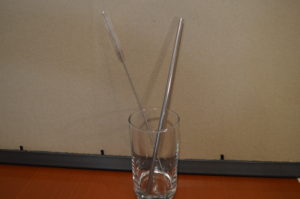By Ayoung Lee | Staff Writer
The internet in the last few years had an influx of people tagging “#SkipTheStraw” or “#StopSucking” in order to persuade peers to forgo the straw when it’s not needed. This trend started when a video of a sea turtle getting a straw pulled out of its nose got posted in 2015. Having always been a person that tried to create as little waste as possible, the video was a shocking reminder to me that straws were a simple tool that I use and toss all the time.
Reusable straws give an alternative to sipping on the go, when leaving in a hurry, in the car, or for people with disabilities. A study by Milo Cress in 2011 found that Americans use 500 million straws everyday which amounts to an average of 49.6 straws a month and 584 straws a year per person.
Standing in public with a cleaning brush washing out their straws may seem weird for people, but when someone thinks of the number of straws they use in a year, or a month alone, they may find that cleaning a straw is something they would be willing to do. Another option for not being stranded washing straws in public bathrooms would be to carry multiple straws around on you.
I like to carry a few straws around so that I have the option to offer them to friends and family when we order some drinks together at a restaurant or a fast food joint.
For traveling, people can buy folding straws which, while pricier at $13.98 on Amazon, gives the comfort of portability and takes up less space. Folding straws typically come with a cleaning brush in the case that it folds up in so that people can clean on the go. I’m a fan of the folding straw as it takes up less space and you don’t need to worry about making sure you packed the cleaning brush separately. However, if you wanted to carry more than one of the folding straws it ends up becoming an investment. The more traditional route would be the straight or bent straws in various lengths. Straight and bent straws can come in different materials: bamboo, stainless steel, silicone, or durable plastic.
Durable plastic straws are the cheapest options someone can get, at $7.99 for 12 on Amazon, but the high-quality ones are a must in these. For the lower-quality ones, the color may chip off or fade quicker than you’d expect and the straws themselves may even crack with some slight biting. Of course with time all durable plastic straws will crack and break, but the higher quality ones will last years, according to reviews.
I enjoy bamboo straws for their ability to last long and be thrown away without worry as they are biodegradable and environmentally friendly. Even bamboo straws can be washed with soap, water, and a cleaning straw after use for sanitation. One worry with bamboo straws is mold. While I have yet to run into an incident where my straw grows mold I am wary of carrying it around just in case the damp environment in the travel case promotes growth.

Straws are easily cleaned with cleaning brushes. (Photo by Ayoung Lee)
Silicone straws are quite useful with their colors and flexibility. For those who have a habit of biting on their straws, silicone straws may be the answer. While the plastic, bamboo, and stainless steel straws are all good options for anyone, for people who bite their straws those options may be quite painful. Silicone, however, has flexibility and allows one to bite down on them without pain. I find that I prefer silicone straws, not only for this reason, but also because it lets me customize my drink in a way that I haven’t been able to before with color.
Stainless steel straws are perhaps the most popular and the most expensive, running you up at a, still reasonable, $7.99 for 8 on Amazon. These straws are good at keeping your drink hot or cold, but also risk burning your lips as one drinks so be careful. My first purchase of reusable straws were stainless steel straws about a year ago and while I love them and use them to this day, they aren’t my first choice. They are hard when I bite down on it, whether by accident or not, the temperature of the drink will be felt on my lips, and they aren’t the easiest to clean when my hands are greasy. That last one is just a small gripe of mine but with other straws I own and have tried it’s just another excuse to not use it as much, though they do last a very long time.
Many people may be wondering how sanitary reusable straws are, and it is a valid question as some people may carry their straws around to use them in place of plastic straws as often as possible. Those interested can buy reusable straws that come with a carrying case or they can buy a separate one for the straws. Some people use pencil cases for them, other people buy the cases separate for cuter designs or for extra cases to put straws in their cars, or some other people make their own from various materials.
Bamboo straws are praised for their biodegradable quality, durable plastic is seemingly preferred for tumbler users as they often come with a ring that keeps them from falling out of the top, stainless steel is popular for their longevity and ability to keep drinks cold or warm, and silicone straws let users have a colorful reminder as to which drink is theirs. While picking out straws, buyers can also pick the length of the straw and sometimes the diameter of the hole. Regular straws would be around eight inches, a small glass like a cocktail or a coffee mug will hold a five or six-inch straw, while a 30-ounce tumbler would hold a 10-inch straw. Straw diameters go anywhere from 7 to 15 millimeters. The larger diameters are best for smoothies and bubble tea drinkers.
People with disabilities who rely on straws to drink may find that it is simpler to carry around their own straws. As companies, such as Starbucks, take steps toward phasing out plastic straws people may find themselves stuck with a drink and no straw leaving them no way to actually consume what they bought. Seattle banned plastic straws back in July, with New York and San Francisco contemplating following this example, so those who travel may even find that carrying straws are a necessity.
Skipping the straw is an easy change that everyone can make in their lives that can also make an impact on the environment where we reduce pounds of plastic from being thrown away every year. Straws are something that are quick to use but take nearly 200 years to decompose, according to the Plastic Ocean Project.
Editor’s note: The New York Times said in 2018 that the number of straws used daily was closer to 390 million a day.







Good article.
Good article
Good article
good article~